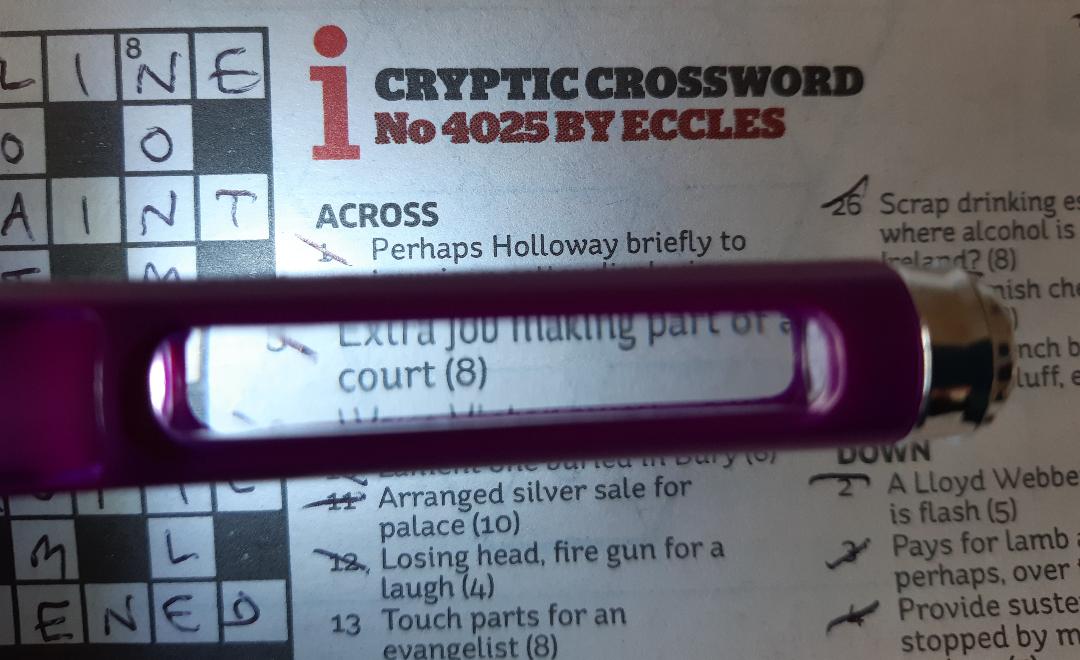Arriving back home in Kent the day after my second cataract assessment appointment, I unpacked and then proceeded to get on the ‘phone to my GP to make sure they’d received the prescription request from Moorfields, and check when it would be ready. After a few minutes on hold listening to some quite jazzy music, I was told by the receptionist that she could see a letter from Moorfields had been emailed through and the prescription should be ready within the next couple of days. “Excellent – that was easy!”, I thought to myself as I went to dig out a Freezer Surprise for dinner as I had barely any fresh food in the house after having been away for a few days. I really must learn to label the dinners I put in the freezer.
Alas, my satisfaction was short-lived as the ‘phone rang. It was the GP’s receptionist again, telling me that although they’d received a letter from Moorfields, it said nothing about the need to prescribe eye drops. I was bemused. “Nothing at all?”, I asked. “No”, she said, “I’m afraid you’ll need to contact Moorfields and get them to send the letter requesting the prescription through as otherwise we can’t prescribe it.” I sighed at the thought of how long it would take me to get through to a human being at Moorfields but agreed to do so before asking if she could forward me a copy of the letter by email so that I could read what they had said. I was told that I’d need to email the surgery to put my request in writing. I sighed again, and fired off an email whilst clenching my teeth as the familiar holding music of Moorfields started up.
It took me about 45 minutes to reach the coveted position of number one in the queue, where I seemed to remain for quite some time. However, I was damned if I was giving up. The guy I eventually got through to found the letter on my record. “It does ask your GP to prescribe eye drops”, he told me, sounding somewhat confused. “Does it?”, I asked. “Is it on the second page of the letter or something and they’ve missed it?” “No”, he told me, “It says GP action in bold half way down the page along with the instructions”. I gave up trying to understand what had gone wrong and simply asked him if he could email it to me. Nope – he could only post it, apparently. I suppose I was lucky that he didn’t say it could only be sent by carrier pigeon. After further questioning, it transpired that he could, however, email it to an NHS account. “Could you email it to my GP then, if I tell you their email address?”, I asked, desperately. “Yes, I can do that”, he said. Well, thank goodness for that.
Having absolutely no confidence in the system by this point, I did that irritating thing of ringing the GP back to check that they’d got the email. They had, and I was told that it would be marked as urgent for GP to approve the prescription, which should be done by the next day. Excellent. Whilst I was on the ‘phone to them, I also asked if I could double check that there were no contraindications with another medication I need to take occasionally which, in all the chaos at Moorfields I’d neglected to double-check at the time. I was asked to fill in an e-consult form and told that a GP would get back to me about it. Cue yet another sigh from me, as I logged on and dutifully completed the form even though most of the questions were completely irrelevant but irritatingly set as essential fields.
The next morning, I received a response to my e-consult form in which the GP advised that I probably wouldn’t be able to take my medication along with the eye drops being prescribed, but that I should check with Moorfields. I nearly screamed. Luckily, I was working from home that day, or my office buddy might have been somewhat alarmed. Or should I say, I was supposed to be working from home. I wasn’t being hugely productive, to be honest, which was somewhat irritating as I had a pile of things to get done. I rang the nurse-led helpline at Moorfields and popped the ‘phone down on the desk to let the holding music play out as I slowly moved up the queue once more. The person who eventually answered wasn’t able to answer my question and put me through to a “drugs information line”. Bracing myself for another long wait, I was quite surprised when it was answered immediately.
The person who had put me through clearly hadn’t provided any context to the pharmacist who answered the ‘phone, so there was some confusion to begin with; however once I’d explained that I was a patient needing advice about potential drug interactions, she was really helpful. She took down some details and said she’d call me back. I hung up somewhat reluctantly, wondering if she really would get back to me. An hour or so after that, I received an email from my GP with an attachment – “aha!”, I said to myself triumphantly, “The letter from Moorfields! Finally I might get some clarification!” I opened it up, and firstly tutted and sighed when I saw that the letter recorded the visual acuity in my left eye incorrectly. It was only a slight difference, but nevertheless, it was different to what the nurse had told me it had been, and they hadn’t noted the slightly improved reading with pinhole either. I sighed yet again, but worse was to follow.
The letter went on to state: “we found there to be fluid at the left eye macula”. I stared at the letter, re-reading it over and over again as my heart pounded. The left eye? They hadn’t said anything about fluid in my left eye during the appointment – they’d definitely been talking about my right eye. They re-examined my right eye via the slit-lamp. They noted that it might be something to do with the silicone oil, and when I queried whether it could be this fluid which had caused the recent deterioration in vision in my right eye, they said that was due to the PCO, not the fluid. All of these references related only to my right eye. So why on earth did the letter say that the fluid was found in my left eye? Everything pointed to the fact that this was an error in the letter… but what if it wasn’t? I didn’t want to be putting the drops (when I eventually got hold of the damn things!) in the wrong eye!
I sat at my desk, my work task completely abandoned by this point, staring at the letter on the screen and feeling distinctly queasy. A few minutes later, my mobile rang again. It was a London number. I snatched it up. It was the pharmacist from Moorfields, ringing me back! She told me that fine for me to take the medication I occasionally needed along with the eye drops, carefully explaining in detail why this was the case and what steps I could take to minimise any risks I might be worried about. I then basically pounced on her and told her about the letter I’d finally managed to get hold of. She looked up my record but was clearly reluctant to tell me anything which might not be correct from a medical point of view – and I absolutely understood her stance here. She gave me further advice on how I might have more luck in getting through to An Actual Human Being on the labyrinth that is Moorfields’ automated telephone system, and I thanked her for her help as we ended the call.
Much to my surprise, her advice was successful, and I somehow (am still not entirely sure how!) managed to get through to a switchboard operator, who proceeded to put me through to the relevant medical secretary! This was like striking gold! Or it would have been… until the person who answered told me that the medical secretary was working from home. Argh! However, she told me that she could help and asked me to email her a copy of the letter, saying that she would then contact the consultant. I speedily tapped out an email explaining the issue along with the letter and returned to my day job task feeling more hopeful.
I’d barely typed a sentence of my committee minutes when my mobile rang again. It was the pharmacist calling me back. She told me that she’d looked up the number of the optometrist who I’d seen in the clinic (and who had written the letter) and had called her to ask whether the fluid was in my left eye or my right eye. The optometrist told her that it was my right eye and that she would get the error corrected in the letter. I was enormously relieved, and thanked her profusely for all her help.
I’m now feeling even more grateful to her for taking it upon herself to check and get back to me so quickly, as I still haven’t heard anything from the medical secretaries about the error. If the pharmacist hadn’t been so kind as to investigate herself and let me know, I’d still be sitting here worrying myself silly about which eye has the fluid and which eye I should be putting the drops in. As it was, it took me another day to actually get hold of the drops, which seemed to take ages to be approved by the GP, despite having been marked as urgent.
So… is anyone up for another quiz? Guess how long I spent on the ‘phone to Moorfields and the GP to get all of this sorted out? Obviously, this is including all the holding music and waiting in queues. Actually, having totted it up it’s not as much time as I thought it was whilst in the middle of it all. Ok, are you ready then…? It was two hours and 27 minutes.
More to the point, I still want to know how they managed to write the wrong eye down in the letter – I mean, for crying out loud! Am I over-reacting in feeling entirely frustrated and let down by this whole experience? It’s not good to reach the point where you feel that you can’t trust the medical professionals who are supposed to be caring for you, but I’m afraid that is exactly how I’m feeling after this extended farce.



